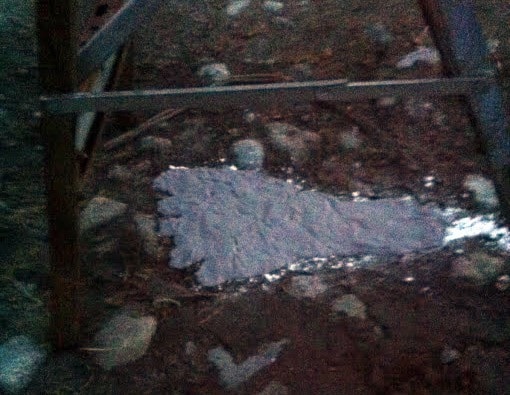On the morning of Tuesday, February 19, Obie Mack looked out his window and spied several huge footprints outlined in mud crossing the street in front of his house. After closer investigation, he quickly called his son, Lorne, to come and take pictures. The print was clearly visible in the mud with tracks crossing the asphalt. With the length of those strides it could only be a sasquatch! Lorne made a mold of the 17 inches print. (only 100 tracks in North America in plaster are archived; all of which resemble a huge human foot but much bigger.) Coincidentally, our Walk/Run group walked by the spot later that day and were able to take pictures. Thrilling and mystifying!
The Bella Coola Valley is no stranger to the sasquatch; in Nuxalk, named “Buks” or “Sniniq”. The McIlwrath books are filled with Nuxalk legends as are most First Nations cultures. The word “sasquatch” was originally an Native word from California.
The famed journalist and recorder of sasquatch stories, John Green, (now 86) visited Bella Coola in the 1950s and gathered the following sightings: 1940s - at Jacobsen Bay by Clayton Mack; 1958 at Burnt Bridge by George Robson and Bert Solhjell; 1962 in the estuary by an unnamed woman and 2 children; 1965 at Green Bay by Jimmy Nelson; 1969 near Anahim Lake by Pan Phillips.
Several Elders have shared their stories with me on Elders’ picnics; sadly some of those Elders have passed away. Clayton Mack is seen in a recently enlarged photo in the Bella Coola Valley Inn restaurant holding his Bigfoot mold. Two stories of sightings around 4-Mile are currently circulating.
Fact or Fiction? I vividly remember the day in 1967, as a young teen, my father’s “Argosy” magazine, for hunting/fishing enthusiasts, lay on the kitchen table. The cover displayed the now famous picture of a “sasquatch” taken by Roger Patterson and Bob Gimlin. This picture from a 16mm film of a female has stood the test of decades of forensic study and has not been discounted. I was to remain intrigued by these stories all my life.
I was later to meet Dr. John Bindernagle, a respected wildlife biologist and one of the foremost authorities on this topic. He pioneered scientific study of Bigfoot. He had joined one of my 4-day kayak trips to learn to paddle. Why? So he could paddle into almost inaccessible places by kayak to set trip cameras on wildlife trails to capture a sasquatch on film. This unassuming man told great stories around the campfire!
His aim has always been to establish scientifically reliable knowledge, not through tabloid journalism but careful analysis and professional review. He has recorded sightings, tracks, stories and existing evidence and data. This is included in his book, “North America’s Great Ape: The Sasquatch”. Bella Coola is mentioned in several places. A hunter east of Bella Coola watched a sasquatch eating berries using its hands. Bears don’t do that!
“The Discovery of Sasquatch”, his 2010 version, challenges the perception that seems to persist; the sasquatch is “widely dismissed as a misidentified bear or a human hoaxer” - even after over 3000 documented North American sightings.
John is not alone. There are conferences of other like-minded biologists who travel the world to record the data on the sasquatch. In North America stories abound from California northward on the West Coast to Colorado and as early in European history as the 1750’s by explorers in western Saskatchewan.
And here is the best news of all! Andrew Robson, descendent of the original settlers of the Valley, is an author and researcher on the topic. He has written “Sasquatch Revelations of Bella Coola”, a compilation of 35 local stories (many from signed affidavits) and Nuxalk stories. It will be available at Kopas Store in April. Amazing!
The stuff of legends or the most misunderstood almost extinct large mammal in North America?
Check out www.coloradobigfootresearch.com for more information on recent research and www.sasquatch-bc.com for John Green’s website and Andrew’s site www.sasquatchrevelations.com
